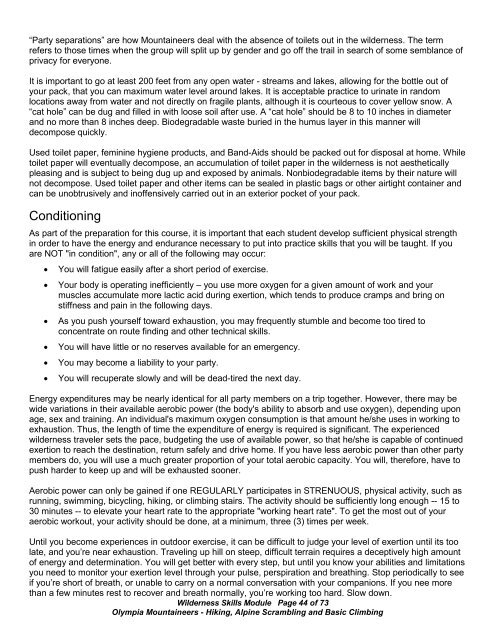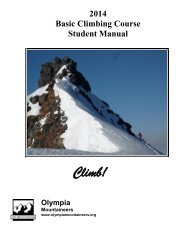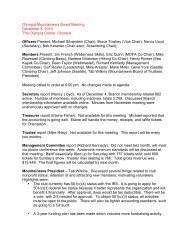Wilderness Skills - Olympia Mountaineers
Wilderness Skills - Olympia Mountaineers
Wilderness Skills - Olympia Mountaineers
You also want an ePaper? Increase the reach of your titles
YUMPU automatically turns print PDFs into web optimized ePapers that Google loves.
“Party separations” are how <strong>Mountaineers</strong> deal with the absence of toilets out in the wilderness. The term<br />
refers to those times when the group will split up by gender and go off the trail in search of some semblance of<br />
privacy for everyone.<br />
It is important to go at least 200 feet from any open water - streams and lakes, allowing for the bottle out of<br />
your pack, that you can maximum water level around lakes. It is acceptable practice to urinate in random<br />
locations away from water and not directly on fragile plants, although it is courteous to cover yellow snow. A<br />
“cat hole” can be dug and filled in with loose soil after use. A “cat hole” should be 8 to 10 inches in diameter<br />
and no more than 8 inches deep. Biodegradable waste buried in the humus layer in this manner will<br />
decompose quickly.<br />
Used toilet paper, feminine hygiene products, and Band-Aids should be packed out for disposal at home. While<br />
toilet paper will eventually decompose, an accumulation of toilet paper in the wilderness is not aesthetically<br />
pleasing and is subject to being dug up and exposed by animals. Nonbiodegradable items by their nature will<br />
not decompose. Used toilet paper and other items can be sealed in plastic bags or other airtight container and<br />
can be unobtrusively and inoffensively carried out in an exterior pocket of your pack.<br />
Conditioning<br />
As part of the preparation for this course, it is important that each student develop sufficient physical strength<br />
in order to have the energy and endurance necessary to put into practice skills that you will be taught. If you<br />
are NOT "in condition", any or all of the following may occur:<br />
• You will fatigue easily after a short period of exercise.<br />
• Your body is operating inefficiently – you use more oxygen for a given amount of work and your<br />
muscles accumulate more lactic acid during exertion, which tends to produce cramps and bring on<br />
stiffness and pain in the following days.<br />
• As you push yourself toward exhaustion, you may frequently stumble and become too tired to<br />
concentrate on route finding and other technical skills.<br />
• You will have little or no reserves available for an emergency.<br />
• You may become a liability to your party.<br />
• You will recuperate slowly and will be dead-tired the next day.<br />
Energy expenditures may be nearly identical for all party members on a trip together. However, there may be<br />
wide variations in their available aerobic power (the body's ability to absorb and use oxygen), depending upon<br />
age, sex and training. An individual's maximum oxygen consumption is that amount he/she uses in working to<br />
exhaustion. Thus, the length of time the expenditure of energy is required is significant. The experienced<br />
wilderness traveler sets the pace, budgeting the use of available power, so that he/she is capable of continued<br />
exertion to reach the destination, return safely and drive home. If you have less aerobic power than other party<br />
members do, you will use a much greater proportion of your total aerobic capacity. You will, therefore, have to<br />
push harder to keep up and will be exhausted sooner.<br />
Aerobic power can only be gained if one REGULARLY participates in STRENUOUS, physical activity, such as<br />
running, swimming, bicycling, hiking, or climbing stairs. The activity should be sufficiently long enough -- 15 to<br />
30 minutes -- to elevate your heart rate to the appropriate "working heart rate". To get the most out of your<br />
aerobic workout, your activity should be done, at a minimum, three (3) times per week.<br />
Until you become experiences in outdoor exercise, it can be difficult to judge your level of exertion until its too<br />
late, and you’re near exhaustion. Traveling up hill on steep, difficult terrain requires a deceptively high amount<br />
of energy and determination. You will get better with every step, but until you know your abilities and limitations<br />
you need to monitor your exertion level through your pulse, perspiration and breathing. Stop periodically to see<br />
if you’re short of breath, or unable to carry on a normal conversation with your companions. If you nee more<br />
than a few minutes rest to recover and breath normally, you’re working too hard. Slow down.<br />
<strong>Wilderness</strong> <strong>Skills</strong> Module Page 44 of 73<br />
<strong>Olympia</strong> <strong>Mountaineers</strong> - Hiking, Alpine Scrambling and Basic Climbing




